Reinstate the Sotheby's 2
New Bond St, London. Fri 31 Jul 2015
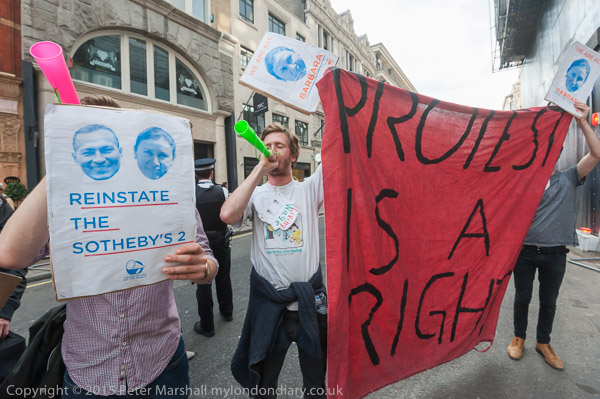
Protest is a right - but Sotheby's have sacked
Percy and Barbara for protesting
more pictures
Members and supporters of the grass roots trade union United Voices of the World marched noisily several times around the block at Sotheby's demanding reinstatement of two cleaners sacked for protesting for proper sick pay, paid holidays and pensions. Short rallies at the front and rear entrances were watched by police.
Originally Sotheby's barred four cleaners for taking part in the
protest, but after pressure two were allowed to work there again. But
Percy and Barbara who were more active in organising the people who
worked there remain sacked, victimised because of their trade union
activities.
more pictures
BBC protest over Palestinian Hunger Strikes
Broadcasting House, London. Fri 31 Jul 2015
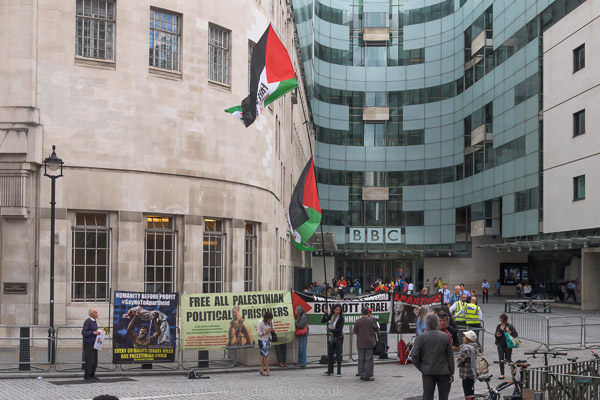
Protesters outside the BBC which has failed to
report the hunger strikes against administrative detention
more pictures
Protesters at Broadcasting House demanded the BBC end its
anti-Palestine bias and report the hunger strike by Muhammad Allan and
Uday Isteiti in Israeli jails, now in its 6th week, against indefinite
illegal administrative detention.
The protest, organised by Innovative Minds in co-operation with The
Prisoner's Centre for Studies in Jerusalem, drew attention to the
continuing pro-Israel bias among management and some reporters at the
BBC. There have been many complaints, and at least two have been upheld
by the BBC’s Editorial Complaints Unit. Last year BBC News Online
presented a highly contentious report from someone working in an
'explicitly pro-Israeli' organisation as being from an independent
defence analyst, and earlier this year Sarah Montague on the R4 Today
programme allowed Israeli Defense Minister Moshe Ya’alon to make highly
controversial claims without questioning them.
There has been controversy too over many other distortions or failures
to report events such as these hunger strikes, and about the undue
pressure on some correspondents who have reported from Gaza and
elsewhere. Many who used to regard the BBC as a great institution and
praised its high standards are now disillusioned and feel that they need
to listen and watch other broadcasters to get an impartial and more
complete view of both overseas and UK news.
more pictures
National Gallery Leaving Party
Trafalgar Square, London. Thu 30 Jul 2015
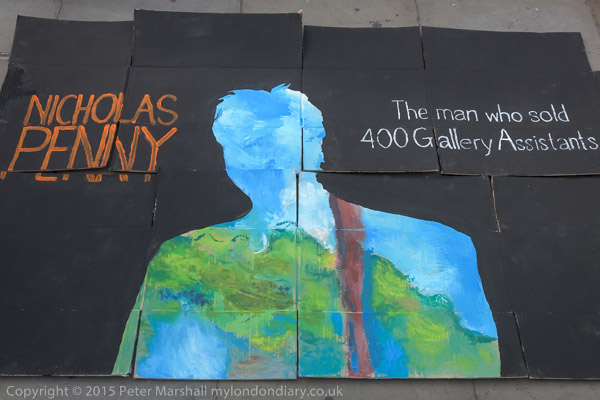
Striking National Gallery staff poster for their alternative leaving
party for Nicholas Penny
more pictures
Workers taking action against privatisation of the gallery picketed the leaving party for Director Sir Nicholas Penny calling for the reinstatement of victimised PCS rep Candy Udwin and talks over the alternative plans put forward by the PCS.
They feel let down by the gallery director who they say has seldom been
seen in the gallery in the last year and has not had any meaningful
discussions with the union over the alternative plans they have put
forward. And despite saying that he does not feel it is the way the
gallery should be going, has signed contracts for privatisation.
After a rally and party with party snacks and fizzy wine in front of the
gallery in Trafalgar Square, the staff who had not received invitations
to the official leaving party formed a picket line at the sides of the
entrance and handed out leaflets about their dispute to those going in.
more pictures
Loddon & Thames
Winnersh Triangle to Reading. Mon 27 Jul 2015
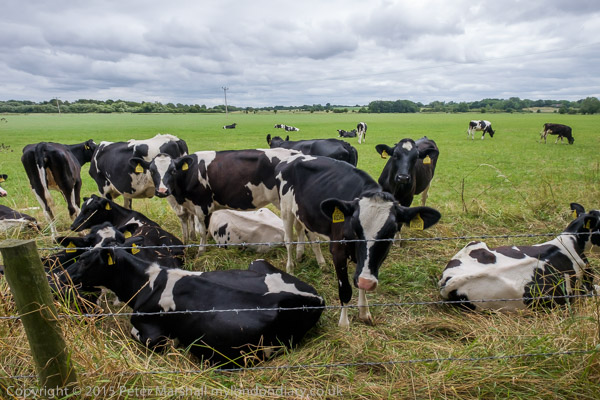
Cows next to a footpath by the River Thames
more pictures
Winnersh Triangle sounds like a dangerous place to go, a new halt (hardly a station with a platform only a foot or two wide) on the Waterloo to Reading line that opened in 1986. It's lightweight wood structure was designed not to put too great a load on the Loddon Viaduct on which it hangs, though there is a ticket office at ground level, closed when we arrived.
Mostly Winnersh Triangle is home to company men and the companies they work for in what the web site describes as "an 85-acre, mature business environment" between the A329M motorway, the rail line and the River Loddon. The web site says it's a place where "everyday things become exceptional and exceptional things happen every day", but very little seemed to be happening on the day we went there. It didn't look like a place where anything of interest ever happened, and its big selling point is that you can be at Heathrow in 30 minutes.
We took a quick look, didn't like it and headed south under the railway to walk along the Reading Road to Loddon Bridge, joining a footpath that led north beside the River Loddon under the railway and motorway. You've probably never heard of the Loddon, but its a sizeable tributary of the Thames, that often gets too sizeable for its banks, flooding nastily. A man in council hi-viz who was checking the river gave us a 20 minute dissertation on this and related matters before we all escaped, though I'd wandered away taking pictures after the first five.
Fortunately the river was fairly low or we might have been paddling or swimming for the next mile or so, before the path veered away and climbed to a road and we found ourselves briefly in suburbia. Then we came across a large BEA twin prop plane, its presence soon explained by a sign 'The Museum of Berkshire Aviation'. It was closed which saved us from having to decide if we wanted to be enthralled by "Berkshire's dynamic contribution to aviation history."
You can find out more on the museum web site, which includes a picture of a rather dinky little 'Miles Pusher', which was "built by F. G. Miles under protest and therefore never flew." Miles went bust in 1947, and Handley Page took over the designs, accounting for the Handley Page Herald turboprop standing outside. Miles from 1942 had been designing an experimental supersonic jet aircraft to fly at 1000mph, but the Air Ministry in 1946 cancelled this, deciding only to build it as an unmanned rocket-powered scale model which achieved controlled flight at Mach 1.34 - 1020mph. The design of the Miles M52 informed the later English Electric Lightning which I saw at the Farnborough Air Show in the early 1950s and could out-perform anything from that era.
We didn't hang around, though Sam looked up a few things on his mobile and we photographed the Fairey Gannet out the back before going along the footpath and down to the river to continue our path through rural Berkshire alongside the river to Whistley Mill Lane.
This leads to a ford over the Old River, still a stream of the River Loddon, and unless you are driving a LandRover or something larger, its probably best to turn around and go back. The level markers were at 2 feet, but fortunately there is a footpath to a footbridge around 60 yards to the south which we crossed, taking us to the Lands End pub, which might have been a good place to lunch, but we had brought sandwiches.
The next mile or so took us through the Charvil, a suburban fringe of
Twyford, and with some difficulty across the A4 to Milestone Ave, a
narrow lane with some 1930s development on the east side for the first
half mile or so. Just before a bridge over one of the minor arms of the
Loddon, a footpath leads off to the River Thames. We've previously
walked along the Thames path on the opposite bank, which we came on to a
mile or two later as it crosses the bridge at Sonning.
We took a look inside St Andrew's Church there (and were given a copy of
what must be one of the most lavishly produced church magazines in the
country) and briefly explored the grounds before taking the path from
the churchyard to rejoin the Thames path, walking along this into
Reading for the train home.
more pictures
Kurds blame Turks for Suruc massacre
Downing St, London. Sat 25 Jul 2015
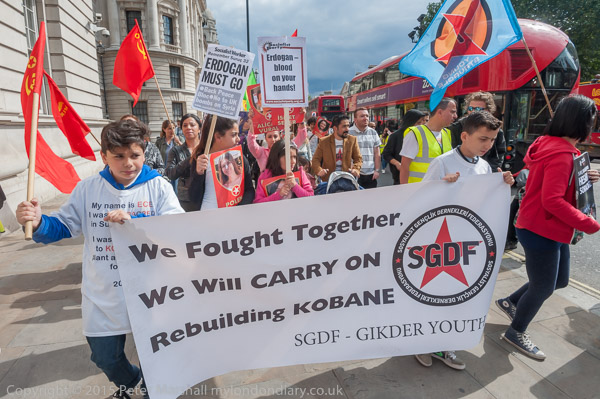 After
the rally at Downing St the Kurds marched off towards the BBC
After
the rally at Downing St the Kurds marched off towards the BBC
more pictures
Kurds and supporters protested at Downing St over the massacre of 32 young activists massacred by ISIS on their way with toys, books and other materials to build a playground, library and other projects in Kobane. They accuse Turkey of aiding ISIS.
The AKP government in Turkey has been fighting for years against Kurds in Turkey who want to free themselves from Turkish domination that has treated them as inferior citizens, outlawing their language and culture, and imprisoning the Kurdish leader, Abdullah Ocalan.
The Turkish government appear to have been allowing ISIS to operate on their border and to allow ISIS to smuggle oil and other goods through Turkey, as well as letting supplies and recruits reach them. They appear to hope that ISIS will solve their Kurdish problem for them by defeating them in Iraq and Syria.
The London Kurds organising this protest say that many Kurds and Turkish socialists here "have seen friends and family murdered in recent days and increasingly over the last few years by the Turkish state as it's nationalist, imperialist and Islamist project has been damaged by the progressive politics of the Kurdish movement."
After a rally with numerous speeches, including one by Kate Osamor, MP
for Edmonton whose constituency includes many Kurds, the protesters set
off to march to the BBC. I left the after around a quarter of a mile to
go home.
more pictures
Make seats match votes
Old Palace Yard, Westminster, London. Sat 25 Jul 2015
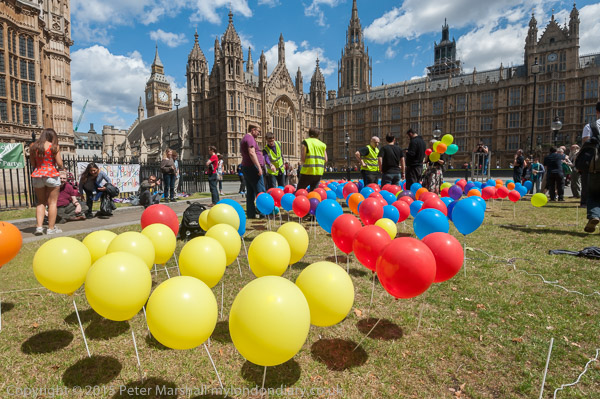
The balloons made up a map of the UK, coloured to
show the parties holding the parliamentary seats
more pictures
After the most disproportionate UK election ever in May, grass roots opinion for a fairer voting system has grown rapidly, with over half a million signing petitions. Around a thousand came to a rally outside Parliament to demand change.
Before the General Election, Owen Winter, the independent member of the youth parliament for Cornwall, created a petition on the website change.org calling for electoral reform; within a week or two it had been signed by over 200,000 people. Together with other similar petitions by other groups on other sites there were over half a million signatures calling for voting reform and a system of proportional representation that would result in a government that reflected how people voted.
The Tory Party were voted for by just under 24% of the electorate, gaining 36.1% of the votes. The 330 seats they won mean that they got one seat for every 34,347 votes. On the same basis, UKIP who got 3,881,129 votes would have got around 113 seats, but they actually got just one. The Green Party were another loser, also with only one seat, despite 1,157,613 votes.
The election has made the unfairness of our 'First Past the Post' system more evident. In a democracy it is clearly untenable, but it suits the interests of our two major parties, as well as the SNP, whose 1,454,436 votes gained them 56 seats. The Liberal Democrats got 1.66 times as many votes as the SNP but these only gave them 8 seats.
The balloon map using different colours for the parties holding seats would have looked quite impressive from a helicopter, but seen at ground level was rather disappointing. Even holding my camera well above my head it was still hard to make much sense of it.
After a short introduction, people went through the 'map' with pins popping balloons for the constituencies where no candidate got over 50% of the votes, though it wasn't too clear why. Possibly it made better videos than it did still pictures, though I doubt it. It was difficult too to make much visually of the 'Twitterstorm' on #MakeSeatsMatchVotes and given the disappointingly low turnout for what had been billed as a 'Great Gathering for Voting Reform' it was probably more of a very light Twittershower.
What was lacking was any clear idea of how fairer voting might be
obtained, either in terms of how the voting system could work and how
reform might be accomplished in a way that would retain some of the
advantages of the present system.
One proposal would be to pair up all of the current constituencies into
two-member seats, with one seat going to any candidate with more than
50% of the votes. The remaining one or two seats in all constituencies
could then be allocated to represent (together with the seats already
allocated by majority) the popular vote, with seats to parties, starting
from those with the lowest eligible number of votes who would get one
seat in those constituencies in which they had most support until their
quota was reached. Candidates would still stand for constituencies and
parties could nominate one or two candidates for each constituency, one
being listed on the ballot and a second for the 'list' seat only so that
they did not split the vote.
There could of course be quite different constituencies, but a reduction
from the current 650 to 325 would keep most of them to a reasonable
size. A scheme like this would enable us to keep the idea that members
represent constituencies and they would end up representing those in
which they had considerable support. Many constituencies would have two
MPs from different parties, which might be an advantage to constituents
- and a little competition between the two might be good. It also avoids
the idea of a 'party list' which many would find unacceptable or
undesirable.
more pictures
Free Steve Kaczynski from Turkish Jail
Turkish Cultural Office, Kingsway, London.Sat 25 Jul 2015

A woman from the Turkish Popular Front hands out
leaflets at the protest
more pictures
A protest outside Craven House on Kingsway which houses the Counsellor’s Office for Culture & Information of the Turkish Embassy called for the immediate release of Steve Kaczynski, a left-wing activist arrested in a raid in April on a left-wing Turkish cultural centre on suspicion of being a British spy and still in jail without charge, now on hunger strike.
Kaczynski, born in Scotland and at one time employed by the BBC World Service on Turkish affairs has for years supported the Turkish community in the UK with translations and advice over employment and immigration. He was at a Cultural Centre in Turkey to show international solidarity against fascism when it was raided by Turkish police following a hostage incident in a courthouse where a state prosecutor and the two gunmen holding him captive were killed. There is no suggestion that he was involved in this incident.
Turkish media repeated government rumours about his being a British or
German spy but there is no evidence of this, and those who know him find
it impossible to believe. He has not been charged and his arrest is seen
as a part of a systematic programme by the AKP Turkish government to
intimidate any political opposition.
He is known to people on the left in the UK, despite the kind of
political differences that often separate people, as a kind and gentle
man who abhors violence and has long campaigned for human rights and
political freedom. Those at the protest included some from the British
left as well as the Turkish Popular Front in the UK. The protesters sang
and chanted and made a lot of noise as well as handing out leaflets
explaining the case and calling for his immediate release.
more pictures
Festival of Our Lady of Mount Carmel
St Peter's Italian Church, Clerkenwell, London. Sun 19 Jul 2015
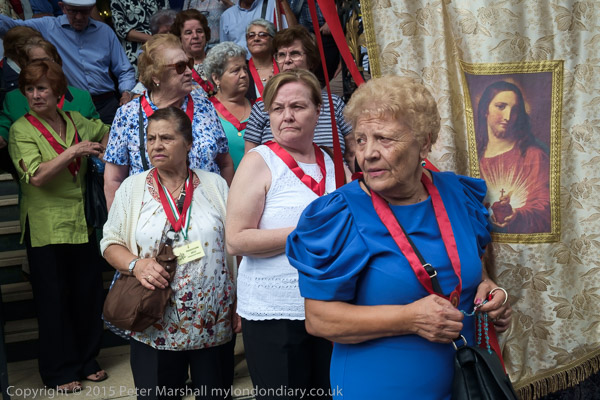
Catholic women with the banner they are to carry
in the procession of Our Lady of Mount Carmel
more pictures
The procession of Our Lady of Mount Carmel, which was the first Roman
Catholic event on English streets for 349 years when first allowed by
Queen Victoria in 1883, took place in Clerkenwell from St Peter's
Italian church founded over 150 years ago. more pictures
10 years since Iran hanged gay teenagers
St Martin-in-the-Fields, Trafalgar Square, London. Sun 19 Jul 2015
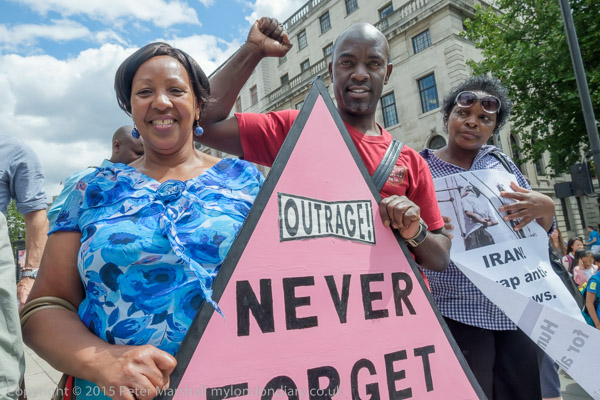
Outrage's pink triangle edged with funereal black
and the message 'Never Forget'
more pictures
Peter Tatchell Foundation and African LGBTI group Out and Proud
held a memorial vigil on the steps of St Martin-in-the-Fields for
teenagers Mahmoud Asgari and Ayaz Marhon publicly hanged by agonising
slow strangulation because they were gay in the city of Mashhad, Iran
on 19 July 2005.
more pictures
Ecuadorians support 'Citizen Revolution'
Trafalgar Square, London. Sun 19 Jul 2015
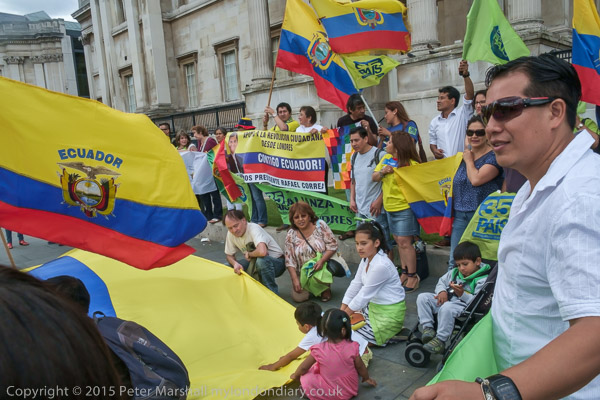
The Ecuadorians get themselves organised for a
group photo in front of the National Gallery
more pictures
Ecuadorians brought flags, posters and t-shirts to Trafalgar Square
to support President Rafael Correa, threatened by right-wing protests
as his 'citizen's revolution' which has reduced poverty and the
influence of the US, IMF and multinationals.
more pictures
Eritreans Vigil for Peace?
Downing St, London. Sat 18 Jul 2015
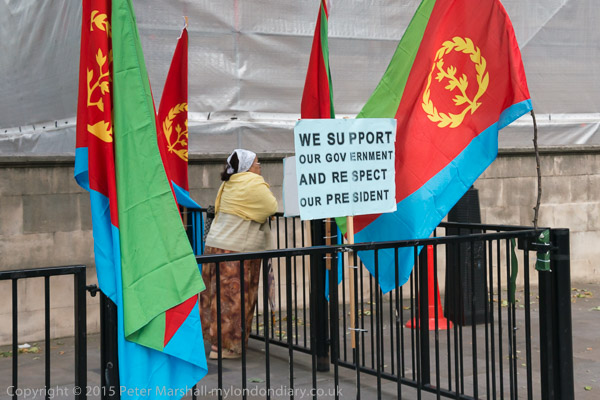
A woman at the vigil with Eritrean flags and
poster 'We Support our Government and Respect Our President'
more pictures
Since 26th June, a few Eritreans have conducted a non-stop vigil opposite Downing St, started by patriotic Eritrean Yacob Ghebremedhin. There are also larger protests on the first Friday of each month "under the banner of FenQ'l".
Their main demands are for the full and unconditional Implementation of the Algiers Agreement, including the ruling of Eritrea Ethiopia Boundary Commission, which followed the ending of the war between Ethiopia and Eritrea, for the lifting of the UN sanctions imposed on Eritrea in 2009 and 2001 which they blame on US pressure, and for "the total rejection of the so called Commission Of Inquiry on Eritrea’s report based on fabrications and lies, and aimed at tarnishing the good image of Eritrea, its peoples’ cherished cultural values, government and the Eritrean Defence Forces."
The United Nations Commission of Inquiry (COI) on Eritrea was released in June this year. In an op-ed, Rachel Nicholson of Amnesty International stated:
"Its findings are damning: systematic, widespread and gross human rights violations have been and continue to be committed under the authority of the government."
"In 484 pages of detailed findings, based on interviews with 550 witnesses and 160 written submissions, the Commission describes the rule by fear through which Eritrean citizens are systematically stripped of their fundamental freedoms: in the report’s own words, ‘controlled, silenced and isolated… abused, exploited and enslaved.’"
"The Commission’s findings tally with the violations reported consistently by Amnesty International and other human rights organizations over many years, including extra-judicial killings, arbitrary arrests and incommunicado detention, enforced disappearances, torture, forced labour in indefinite national service and severe restrictions on freedom of expression and religion. In the 22 years since independence, the government has systematically crushed any opposition, silenced all forms of dissent and punished anyone who refuses to comply."
She goes on to say that the Eritrean government closely controls access to the country and refuses entry to those who try to investigate human rights. Eritreans abroad "feared reprisals by the authorities, either against themselves or family members still living in Eritrea, and believed that the authorities were able to monitor their activities through a network of spies and informants in the diaspora."
This isn't the whole story, but an important and undeniable part of it. Other posters talked of Eritrea as a "self reliance nation free from any external pressure", meaning that it isolates itself so as to resist the huge external pressures on its socialist regime from neo-colonial powers, particularly the USA.
I'd photographed the vigil on the day it began and had talked to two of
the men present, but had not written about it, being unhappy with some
of the answers they gave and with my pictures, as several protesters
seemed unwilling to be photographed. Both then and today there were half
a dozen Eritreans at the vigil.
more pictures
Falun Dafa vigil against Chinese Atrocities
Downing St, London. Sat 18 Jul 2015
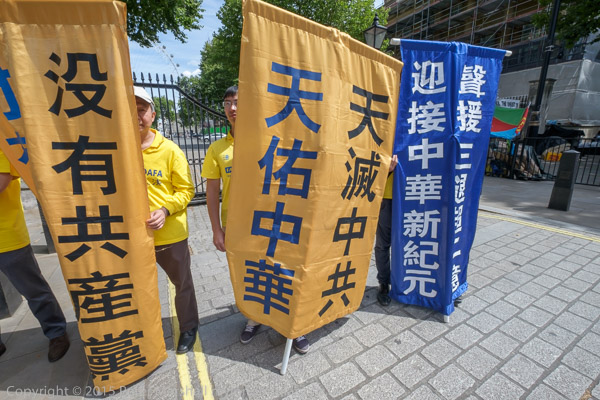
Falun Dafa protesters hold Chinese banners at the
protest
more pictures
A silent vigil at Downing St bore witness to the tens of millions who practice Falun Dafa who are facing imprisonment, torture or even death at the hands of the Chinese regime. They say more than 60,000 have been killed for their vital organs to be sold.
Women in white held pictures surrounded by flowers of Falun Dafa
supporters killed by the Chinese Regime who see its core teachings of
truthfulness, compassion and tolerance as a threat. They say many are
killed to use their organs for transplants.
more pictures
Whitecross Street Festival
Whitecross St, London. Sat 18 Jul 2015
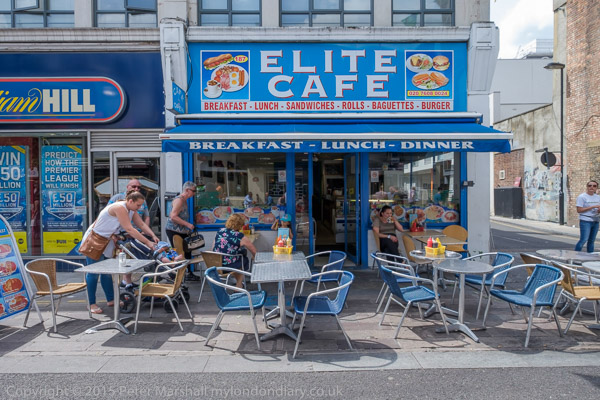
Whitecross St still has traces of its past despite
gentrification
more pictures
Whitecross St, just to the north of the Barbican Centre, was lined
with stalls and a couple of stages for the festival. The street still
retains a little of its old character despite considerable
gentrification, with most of the old businesses being replaced by
galleries, offices, clothes shops, estate agents, bars etc.
A few of the old shop fronts are now fronts for rather different
establishments. The people enjoying the festival included some of the
older residents still in the area as well as newcomers, but it still
made me sad, and I didn't stay long.
more pictures
Justice for Tyree
US Embassy, London. Sat 18 Jul 2015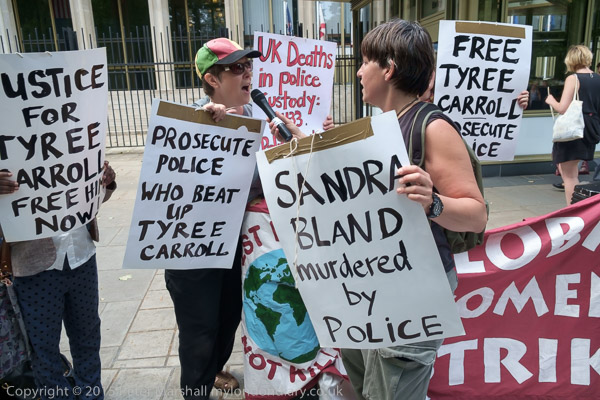
Protests call for justice over the death of Sandra
Bland and beating up of Tyree Carroll
more pictures
People at the US Embassy in London supported protesters in Philadelphia against the brutal beating by up to 26 officers of Tyree Carroll, a young black man caught cycling the wrong way on a one way street, recorded on video. He remains under arrest.
The protest, described as a 'flash protest' and had only been called fairly late the previous afternoon, and was not surprisingly poorly attended. As several of those who spoke pointed out, the beating and arrest of Carroll was only one of many cases of violence against black people by police in the US, and posters also called for Justice for Sandra Bland, found hanged in a jail cell in Waller County, Texas, five days ago, three days after she had been arrested following a routine traffic stop.
Speakers also mentioned other black people killed by police in the US,
as well as those killed by police and security guards here in the UK,
including Jimmy Mubenga, killed during a forcible deportation
attempt and Mark Duggan, targeted and shot by police in
Tottenham. Two armed police officers watched from a distance inside the
embassy fence, and two other officers strolled over briefly to listen
but took no action.
more pictures
Reinstate the Sotheby's 4
New Bond St, London. Thu 16 Jul 2015
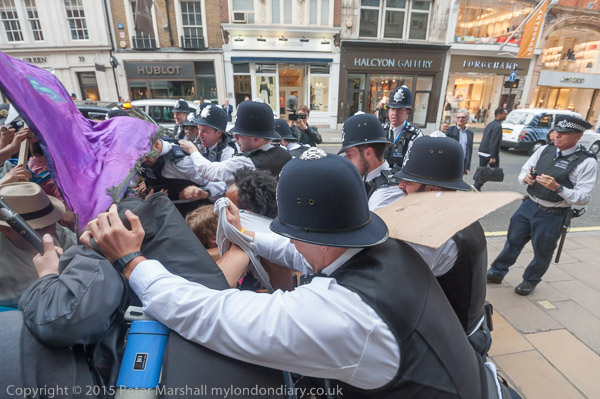
Police almost rip a shirt from a protesters back
as they try to stop them from marching
more pictures
Aggressive policing led to some angry scuffles at what would have been an entirely peaceful third protest by United Voices of the World at Sotheby's calling for the four workers sacked for protesting to be reinstated. The protest had been held to demand proper sick pay, pensions and holiday pay for cleaners and other outsourced workers there.
The protesters met at Oxford Circus before marching the short distance to Sotheby's in Old Bond St. As the arrived on the road in front of the auction house they were stopped by a line of police who told them they most go to the pavement on the opposite side of the road where barriers had been set up to form a pen. There were more barriers on the pavement in front of Sotheby's and around the entrance.
The protesters told police that they intended to protest on the pavement outside Sotheby's, and it was hard to see any reason at all for not allowing them to do so, as the door was locked and not in use. The protesters stood in the street and argued with police. After around 5 minutes, the line of police linked arms and moved forward, pushing most of the protesters onto the pavement opposite. A few managed to evade them but were also forced across the road.
The protesters then held a rally for around 15 minutes, with various people including UVW General Secretary Petross Elia and victimised PCS rep Candy Udwin, sacked by the National Gallery for her union activities, leading the chanting.
The protesters then decided to march around the block, and set off down New Bond St, with police attempting with little success to stop them, but pushing many of them around. But others simply walked through, with someone igniting a red smoke flare to add a little to the confusion. Another flare was set off as they walked around past Sotheby's rear entrance. This was guarded by a small line of police, and others walked along on the other side of the protest.
The march returned to the front entrance of Sotheby's and was again stopped by police who pushed them, at times rather roughly, on to the pavement and behind the barriers. The protest continued noisily there for another 20 minutes before the protesters again tried to march. This time police were more forceful in stopping them and there were a few minutes of angry confrontation at the southern end of the pen.
It looked for some moments as if the protesters were about to push past the police line, and more police came round to help, moving away from the barriers. The protesters who had been standing back then unhooked some of these and walked out onto the street and there were then more angry scuffles and a certain amount of chaos. Several protesters were thrown bodily by police back on the pavement but surprisingly none were seriously injured. Another police car and a police van arrived with yet more police and the protesters were nearly all pushed back behind the barriers which had been restored.
The protest continued with a line of police facing the protesters over the barriers, and it looked for some minutes as if police were preparing to arrest the UVW General Secretary Petross Elia who was arguing vociferously with them. But there were a few more speeches and things settled a little before Petross spoke to one of the officers indicating that the protesters were ready to leave the area. He went to speak to the senior officer and came back with the the message that they could leave.
The protesters then marched away from Sotheby's going up to protest
briefly outside the BBC before dispersing, but I was already late and
went in the opposite direction to catch a bus to Waterloo.
more pictures
The Jurors
Runnymede, Surrey. Mon 13 Jul 2015
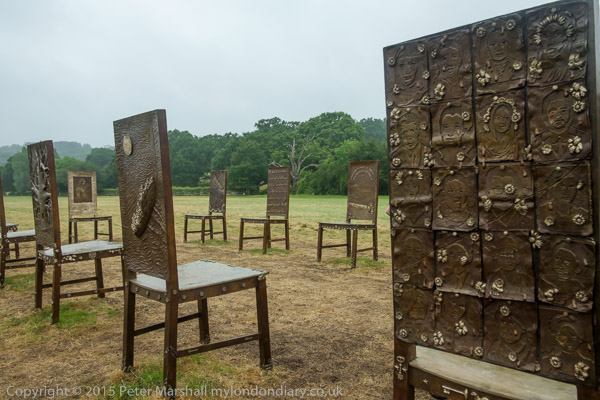
The chairs on the grass at Runnymede - the closest shows a display of
the disappeared
more pictures
The Jurors is an artwork
by Hew Locke for Runnymede, Surrey, UK to mark the 800th anniversary
of the sealing of Magna Carta. Commissioned by Surrey County Council
and National Trust. It consists of 12 bronze chairs incorporating
symbols and imagery representing concepts of law and key moments in
the struggle for freedom, rule of law and equal rights.
The chairs are set in the meadow at Runnymede, below the hill where
Surrey County Council and the police celebrated the Magna Carta
anniversary by surrounding the Runnymede
Eco Village and denying them their civil rights and obstructing
their planned celebration of 800 years of freedom.
If you visit The Jurors, it's worth taking the short walk up the hill to
visit the Eco Village, currently still occupying the woodland after
various attempts to evict them after a judge decided that there case,
involving the assertion of rights granted by Magna Carta and its 1217
companion Charter of the Forest as well as the rather more recent
European Convention on Human Rights deserved a proper hearing.
It was raining slightly as we walked along by the Thames towards
Runnymede, and the rain came on rather heavier as we reached the group
of 12 chairs , set out as if around an invisible table, with five on
each side and one at either end. We had stopped on our way at the nearby
public toilet behind the tea-room, where there were leaflets
explaining the depictions on the chairs - online the large
print version is clearer. You can also download an audio
guide, though the site warns it is best to do so before going to
the site.
more pictures
Surround Harmondsworth - end immigration detention
Harmondsworth Immigration Detention Centre. Sat 11 Jul 2015
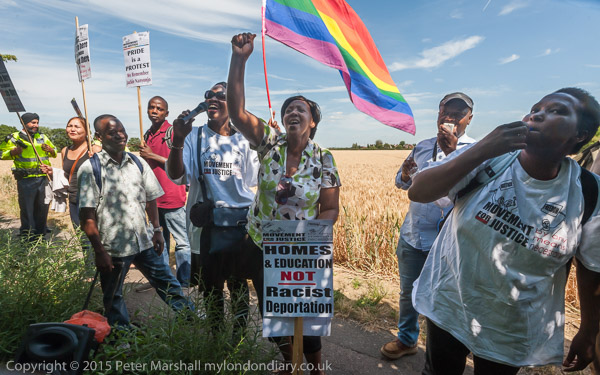
After protesting outside the Harmondsworth
prison, the MfJ moved on to the footpath by Colnbrook
more pictures
Movement for Justice protested at Europe's largest detention centre complex which holds many on Fast-Track, now found unlawful by the High Court. It called for all such centres to be shut, and Fast-Track and scapegoating of immigrants to end.
The complex containing both Harmondsworth and Colnbrook immigration detention centres is now know as the Heathrow Immigration Removal Centre, a title which clearly indicates the government's intention not to properly investigate asylum claims but to simply deport those making them as fast as they can. Although the 'fast track' system, designed to make it impossible for people to properly fight their case to stay has now been declared illegal, those held in the centre are still under threat of being bundled onto a plane without a proper chance to present their case.
After meeting at the entrance to the site on the Bath Road, protesters marched to the pen outside the Harmondsworth administration block for a noisy protest. Phone calls to residents inside told the protesters that they could be heard in the prison and that the detainees were uplifted by knowing that people outside knew they were being held and cared about them.
Several of those inside spoke about their ill-treatment, with their phone calls being relayed to the protesters by holding the phone speaker to the megaphone. There were also speeches by a number of people who had been held inside this and other immigration prisons, encouraging those inside to keep fighting for justice.
After a lengthy protest outside the Harmondsworth prison, the
protesters marched off along the Bath Road to the public footpath that
runs alongside the high security Colnbrook immigration prison. They
stopped in a cornfield adjoining the prison where they could hear the
shouts from those inside for "Freedom Now" and "End Detention". Again
contact was established over mobile phones and those inside and
protesting outside where able to share their thoughts and to take part
in chanting together.
more pictures
Al Quds Day march
Portland Place to US Embassy, London. Fri 10 Jul 2015
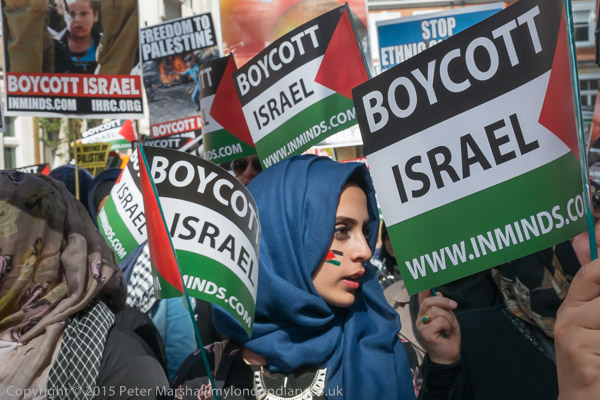
Protesters line up behind the BBC ready for the
march
more pictures
The annual Al Quds Day march on the last Friday of Ramadan, organised by the Islamic Human Rights Commission gathered close to BBC Broadcasting House, marching from there to a rally at the US Embassy, calling for justice and freedom for Palestine.
Several thousand came to the back of Broadcasting House for the start of the march, mainly Muslim, but with a few mainly Jewish supporters from the British left and a group of ultra-orthodox Neturei Karta anti-zionist Jews.
The IHRC receives support from the Iranian regime, and the celebration of Al Quds Day on the last Friday of Ramadan was introduced by Ayatollah Khomeini in Iran 1979 and spread from there to other countries. The roots of the event are quite clear with a large banner carrying a quotation from Khomeini, although support for Iran was less marked than in previous years, and I only saw one protester carrying a photograph of Khomeini.
Most of the banners and placards and the chanting on the march were calling for freedom for Palestine, and there were many placards against Israeli violence in Gaza and the West Bank, and calling for a boycott of Israel, a movement which seems to be growing in strength.
There were too a few - very few - Hezbollah flags and people wearing
badges showing their support. The Neturei Karta had their anti-Zionist
placards, with their message that 'Authentic Jewry Always Opposed
Zionism And the State of "Israel"', but I found no evidence for
anti-semitism, which opponents of the march always charge it with.
Among the groups supporting the march are many organisations involved
with Palestine, including the Ahlulbayt Islamic Mission, Friends of Al
Aqsa, Friends of Lebanon, Innovative Minds, Islamic Centre of England,
Islamic Students Association, Jews for Boycotting Israeli Goods,
Lebanese Community UK, Muslim Association of Britain, Muslim Council of
Britain, Muslim Directory, Neturei Karta International, Scottish PSC,
Sons of Malcolm, Passion Islam, Stop the War Coalition and UK Islamic
Mission.
I left the march as it turned off Regent St to make its way through
Mayfair to a rally at the US Embassy.
more pictures
IWGB protest at Royal College of Music
Kensington, London. Fri 10 Jul 2015
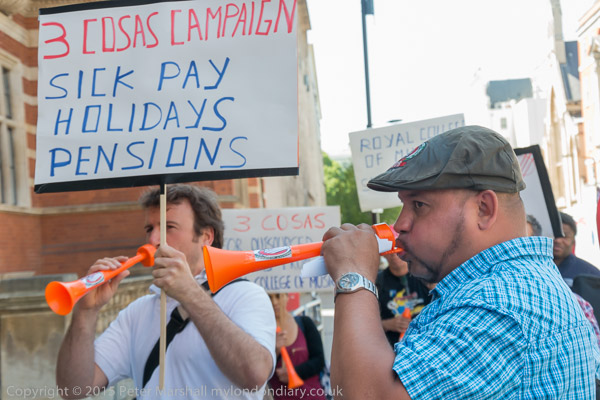
Jason Moyer-Lee and Alberto Durango of the IWGB blow horns outside the
Royal College of Music
more pictures
The IWGB union protested noisily at the Royal College of Music after it failed to respond to their offer of negotiations to achieve sick pay, holidays and pension for outsourced workers similar to workers directly employed by the college.
Security staff at the RCM tried to get the protesters to move away from the area in front of the entrance, but they refused, and their presence there did not greatly impede people entering or leaving. There were more people around than usual as there was a graduation ceremony taking place. The union had offered to call off the protest if the management would talk about their claim for for proper sick pay, holidays and pensions for the outsourced workers.
Quite a few of those going in and out took the flyer about the dispute and some expressed their support. The noisy protest will have been evident to all those inside the building, which would perhaps not have been the case if the protesters had moved away as requested.
There was a minor incident when one woman came out of the building and
remonstrated with the protesters, telling them to go away. When they
refused to do as she asked she assaulted on of them, and the RCM
security quickly led her away.
more pictures
Sotheby's 4 sacked for protesting
Old Bond St, London. Wed 8 Jul 2015

An officer refuses to make eye contact as he
pushes UVW general secretary Petross Elia away from Sotheby's
more pictures
United Voices of the World and their supporters protested at Sotheby's after they sacked four workers who took part in last week's protest for proper sick pay for the cleaners and porters there.
As the week before, the protesters, now calling for the reinstatement of the 'Sotheby's 4' as well as for the original demands for proper sick pay, holidays and pensions met at Oxford Circus. The UVW were supported by other groups and individuals including Class War, SOAS Unison and the PCS workers from the National Gallery.
They marched to Sotheby's, where they made clear to police that they
wanted to protest outside the auction house, while police tried to force
them across to the pavement opposite. After five minutes police began
pushing the protesters, but were only successful after two more police
vans brought reinforcements a few minutes later. The protest then
continued facing Sotheby's from across the road and was continuing when
I had to leave around an hour later.
more pictures
Save Shaker Aamer weekly vigil
Parliament Square, London. Wed 8 Jul 2015
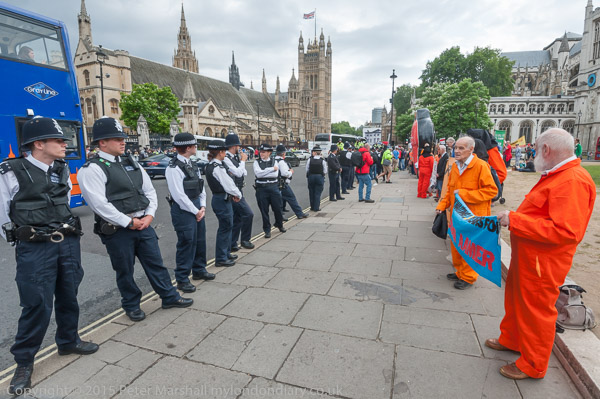
A line of police watch the regular Shaker Aamer
weekly vigil
more pictures
Budget Day was just another Wednesday for the Save Shaker Aamer
Campaign, and they were there to remind MPs that Shaker Aamer, long
cleared for release, is still held, abused and tortured in Guantanamo
and urging his immediate release to the UK.
more pictures
Joint Strikers Budget Day Rally
Parliament Square, London. Wed 8 Jul 2015
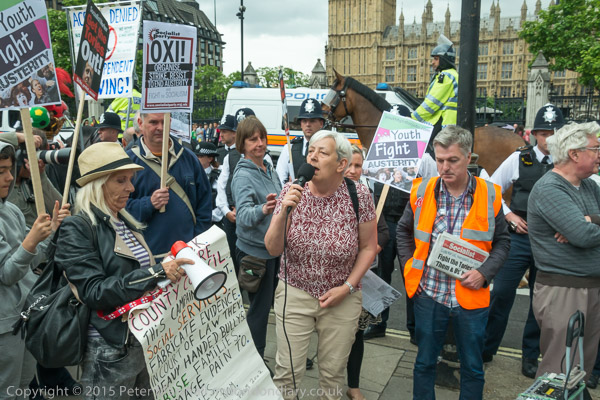
Candy Udwin, victimised PCS rep at the National
Gallery speaks in Parliament Square
more pictures
Public sector workers on strike against the privatisation of the
council services in Barnet and Bromley and of workers at the National
Gallery marched to a rally in Parliament Square while the Budget
speech was being made called by Bromley Unite.
more pictures
DPAC Parliament Square Budget Day protest
Parliament Square, London. Wed 8 Jul 2015
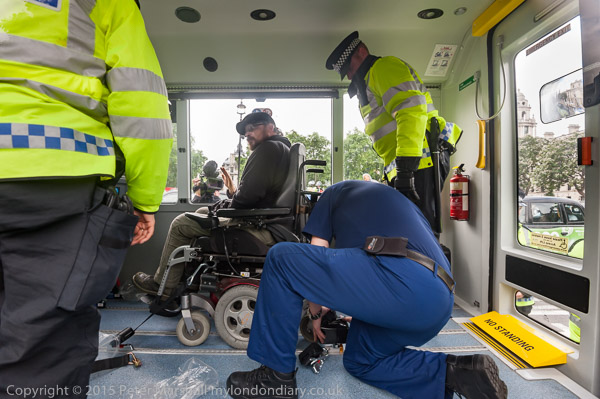
Police secure Andy Greene in his wheelchair inside
a specially adapted van hired for the occasion
more pictures
The DPAC 'Balls to the Budget' protest ended in Parliament Square. After a short rally police moved in to remove the giant banner and protesters from the road. Several protesters, including Andy Greene of DPAC in his wheelchair, were arrested.
When the protesters came off Waterloo Bridge they stopped on the
junction at the corner of Parliament Square blocking all traffic there,
and held a short rally, joined by trade unionists who had come for a
rally there. Traffic standing still on Whitehall had meant that those
marching from the National Gallery, led by Candy Udwin who spoke briefly
here, had needed to get off the road and march on the pavement.
After a short while, large numbers of police came onto the road to
persuade the DPAC protesters to move away, although the police who
included a small group on horses, effectively blocked Parliament Square
for rather longer.
The police arrested at least two of the protesters, and there was a long
wait while they brought in specially adapted hired van to take away Andy
Greene of DPAC in his wheelchair, along with pensioner Terry Hutt.
more pictures
DPAC blocks Westminster Bridge
Westminster Bridge. Wed 8 Jul 2015
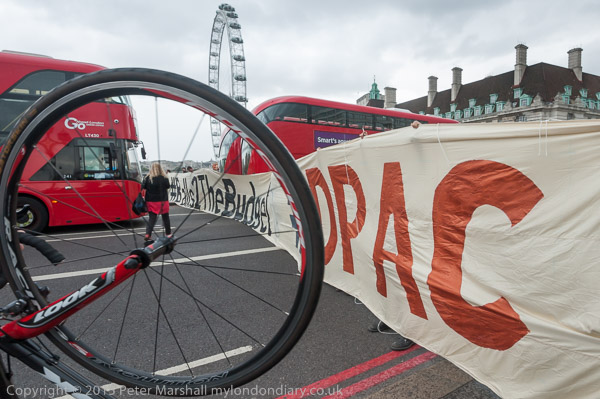
A cyclist pulls up his front wheel as he jumps
off, his way blocked ny the DPAC banner
more pictures
Disabled People Against the Cuts block traffic on Westminster
Bridge on Budget Day with a 23 metre long banner in protest against
cuts hitting the disabled, after displaying it opposite the Houses of
Parliament.
The protesters walked on to the roadway on the bridge with their
banners, while a small group on the embankment unrolled the long banner
and held it on the embankment wall facing the Houses of Parliament.
They then brought it up onto the bridge, where it stretched the whole
width of the bridge, again blocking traffic for a few minutes before
marching with it towards Parliament Square.
more pictures
DPAC 'Balls to the Budget'
Downing St, London. Wed 8 Jul 2015
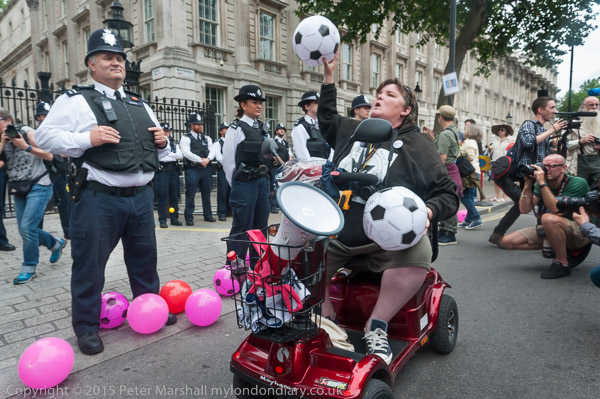
Paula Peters tries to throw a football into
Downing St.
more pictures
Disabled People Against Cuts supporters, some in wheelchairs and mobility scooters, protested against the changes to benefits which will hit the disabled hardest, writing messages on balls and throwing them over the gates of Downing St.
Among other groups supporting the protest were Global Women's Strike, Winvisible, Women Against Rape, Unite Community and Class War. Also at Downing St was political artist Kaya Mar with a Budget Day painting.
After some speeches on the opposite site of Whitehall, Paula Peters of
DPAC lead protesters across the road, including a number on mobility
scooters and in wheelchairs as well as walking. There they stopped in
front of the two rows of police and tried to throw balls of various
sizes over the gates. Some of the larger balls had messages such as 'If
the Tories had a soul they'd sell it', 'Cuts Kill' and 'Blood on your
hands' and a woman carried a large poster, 'Balls to this Bullshit
Budget'. A few did go over the gate, but most fell short.
The protesters then made their way along the road down Whitehall towards
Parliament Square.
more pictures
Darent Valley Path & Thames
Dartford, Kent. Sat 4 Jul 2015
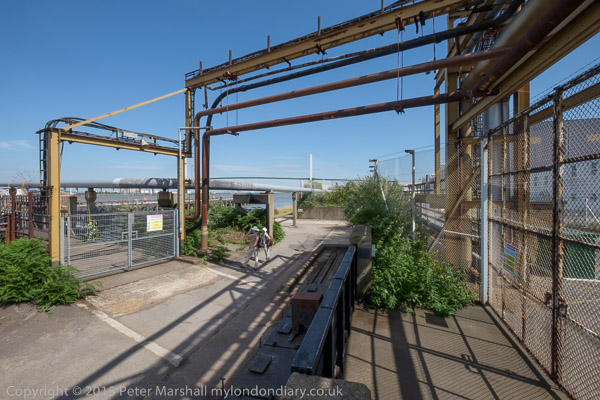
Riverside path at Littlebrook power station
more pictures
Our walk started at Dartford Station, rejoining the Darenth Way. For some reason this does a short and pointless deviation to emerge and cross the river again as it flows into the large ponds which used to be in front of a large pharmaceutical works. Much of this has now gone, with production ceasing a few years ago. Today the pond had some large areas of water lilies.
We made our way up Hythe St past the Hufflers' Arms, a reminder of when the Darent was navigable, and men were needed to pull the barges upstream to the Dartford wharf. A little past there a path took us across the Darent again and on to a riverside path, a route I first walked thirty years ago. Since then The Wellcome Foundation changed to Glaxo Wellcome, expanded, became Glaxo Smith Kline, shortened to GSK and closed down. Some industry still remains on the site, which has been sold to be developed for housing.
The riverside path took us to the lock, now rather derelict with a permanent half-tide barrier to retain water upstream at low tide. Boats can still go over this at or near high tide, and one narrow boat was moored just upstream, and a man from the Friends of Dartford and Crayford Creek, aka Steam Crane Wharf who are trying to restore navigation was working by the lock. We stopped and talked with him for some time, and he told us that a yacht was going to try and come up from the Thames in an hour or two.
Getting under the flood barrier isn't a problem, as it is only lowered
very occasionally at exceptionally high tides, though the river is very
shallow at low tide, but the Dartford bypass (Bob Dunn Way) has a low
fixed span across the river, boats need to come up and under it as the
tide is rising and then wait to travel further up towards Dartford.
The whole creek is now very silted up, with large mud banks in places,
and the permanent half-tide barrier has greatly increased the problem
above it, holding the water so it deposits its load of silt.
The paper works on the west side of the river are also now closed, and
much of the site is now being developed as housing. Downstream of the
bypass the Cray, also navigable for a short length, joins the Darent.
The riverside path is on a tall bank and winds considerably with distant
views over the marshes. It goes past some lakes, past a motocross
circuit, a clay shooting range some distance away, fields and cows, some
derelict square roofless military structures, and the scattered
buildings of a former fireworks factory to the Darent Flood barrier.
We stopped here to eat our sandwiches in the shade of a hedge, about the
only shade between Dartford and Greenhithe where our walk ended. As we
finished we saw a yacht making for the Darent and I ran to photograph it
going under the flood barrier and upriver.
The path alongside the Thames was hot and dusty, taking us past the
sewage farm and Littlebrook Power station which finally ceased operation
this year, to the QEII bridge. As we got to the bridge the Cobelfret
ferry eased out of its berth at Purfleet, turned in the river, and made
its way out towards Zeebruge.
By this time I was getting a little hot and tired and took few pictures
as we walked past Crossways and on to Greenhithe where we took the train
home. We had meant to take a slightly early path away from the riverside
to go up to Stone Church and then on to Stone Crossing, but failed to
see it if it is still there.
more pictures
Ahwazi crash secret UK-Iran business meeting
Westminster, London. Fri 3 Jul 2015
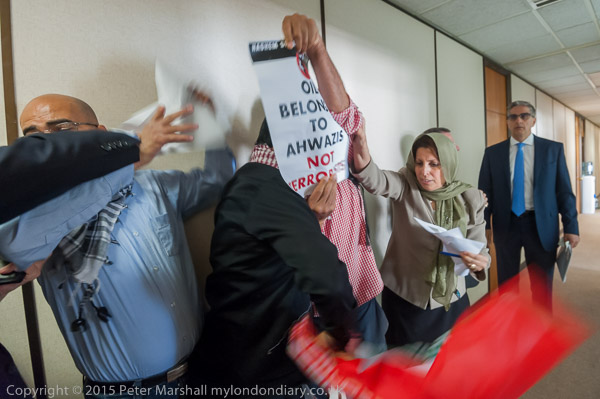
People try to stop the protesters in the corridor
at the British Iranian Chambers of Commerce
more pictures
A small group of Ahwazi Arabs with the support of Peter Tatchell rushed into the secret UK-Iran business talks to protest peacefully against violent persecution of their people in Iran. Several protesters and a press photographer were assaulted by a young Iranian man, thought to be an Iranian agent.
Around fifteen protesters, mainly from the Hashem Shabani Action Group, named after Arab-Iranian poet and human rights activists Hashem Shabani, executed for peaceful opposition to the Iranian regime in January 2014, met outside Westminster Abbey, where they attracted the attention of a security man who was relieved when they assured him they were shortly going to move elsewhere after they had finished making their plans. Some of the protesters would protest outside the building, but a group who were prepared to take direct action would follow Peter Tatchell into the building and rush up the stairs to try and crash the meeting.
Together with two cameramen and several photographers they then made their way to the Tothill St entrance of NIOC (National Iranian Oil Company) House, a building containing the offices of the British Iranian Chambers of Commerce (BICC), which promotes UK-Iran trade and investment and where the secret meeting was taking place on its sixth floor.
The protesters rushed into the foyer and most managed to evade the two or three security staff and make for the stairs, where I and the two other photographers followed them, running up the six stories. After running up six floors I wasn't at my best, feeling rather too old for this sort of thing! It took a little while to find the corridor to the room where the meeting was taking place, with people standing around and taking light refreshments, and there were some arguments in the corridor outside.
After a little pushing the protesters managed to enter the room and carry out their protest against the exploitation of their homeland and anti-Arab oppression by the Tehran regime. Various people were trying to throw us out and I wasn't able to get a picture of Lord Lamont as he was confronted by some of the protesters in the corridor outside, although the other photographers did. He has been one of those pressing for the banning of the peaceful and non-violent (their slogan is 'Our weapons are pens. Our bullets are words') Hashem Shabani Action Group along with Tory MP Richard Bacon, leader of the All Party Parliamentary Group on Iran, who I think is visible in the background of some of my images.
Iran's campaign of violent persecution, forced displacement and the suppression of Ahwazi Arabs began around 1925, largely driven by the discovery of huge oil reserves on the Arab lands. Continued after the Iranian revolution, it has resulted in their homeland, thought to have been the inspiration of the Biblical 'Garden of Eden' becoming a desolate wasteland, the poorest area of the Middle East.
Oil was first discovered there in 1908, and the Anglo-Persian Oil Company formed to exploit it (in was renamed the Anglo-Iranian Oil Company in 1935) was directly controlled by the British government from 1914 to 1951 when it was nationalised under the the National Iranian Oil Company (NIOC.) The UK and USA led the 1953 coup which brought a new agreement which favoured the multinationals and was only ended by the Islamic Revolution in 1978-9, which brought Iranian oil back under the control on NIOC. Iran is the second largest oil exporter in OPEC and still has huge reserves of oil and gas, mostly in the Ahwazi regions.
After around ten minutes of protest at the BICC offices, the protesters and photographers went back down the stairs and attempted to leave the offices. They were held there by police, who made some enquiries about the assault on one of the photographers, who eventually decided not to press charges against the man who police had easily identified. It was thought that his assailant was probably an Iranian secret agent who would be able to claim diplomatic immunity.
After sitting around on the comfortable seating in the foyer for around
45 minutes drinking the fruit juice hospitably brought by the building
manager, police allowed protesters and press to leave and the group,
including those who had stayed outside the building posed for
photographs on the steps outside.
more pictures
Sotheby's 'Dignity under the Hammer' protest
Old Bond St, London. Wed 1 Jul 2015
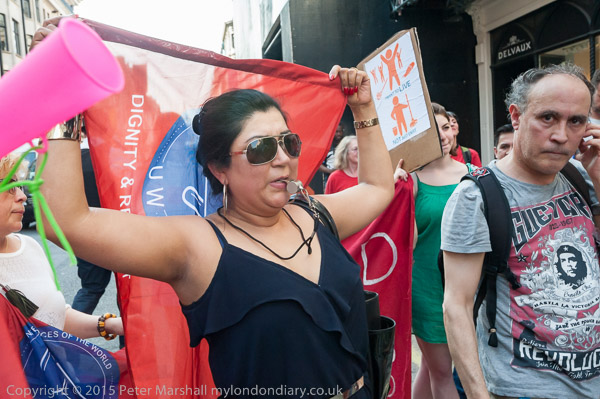
Protesters on the road outside Sotheby's making
a lot of noise
more pictures
A noisy protest at Sotheby's as an auction of art works expected to fetch over £350m was beginning, called for the cleaners and porters who work there to get contractual sick pay and for an end to harassment of workers for union activities.
The protesters met at Oxford Circus and marched down to Sotheby's in Old Bond St with banners, drums, United Voices of the World flags and whistles, stopping on the road outside the auction house. Sotheby's had a black carpet and covered entranceway going across the pavement almost to the curb with a number of security men and a flunkey waiting to greet their customers.
Other protesters, including a group from Class War with their Lucy Parsons banner were waiting for them at Sotheby's. The protesters crowded around the entrance way which was kept clear by police and security and kept up a continuous protest with chants, drumming and other noise, along with some speeches from Petross Elia of the UVW and two of the cleaners, Percy and Barbara.
Some of those going into the auction took the leaflets they were offered, while others tried to ignore the protest; a few stopped briefly to talk. Although noisy and making its demands loudly and angrily, the protest was peaceful and had moments of humour, particularly from Class War, with a dance on the black carpet by Adam Clifford, and some antics from Ian Bone, who rather upset some of the police. The Class War women had brought large water pistols, which mainly they used on other supporters of Class War, with Adam being shot and dying spectacularly in front of the Sotheby's entrance.
Earlier UVW protests at Sotheby's had led to the cleaners and porters working there winning the London Living Wage, contractual sick pay, the reinstatement of our trade union members that had been suspended and dismissed and many other things. But Sotheby's then fired CCML, the company that had been employing the cleaners, and brought in new contractors, Servest, who refused to implement the contractual sick pay that had previously been agreed. They also refused to backdate the payment of the London Living Wage as had also been agreed and were doubtful whether they would increase the rate to the new level when it comes in on Nov 1st.
A letter was sent to all the employees, threatening with sacking if they took part in any protests over the backing down by the company from the agreement that had earlier been reached with CCML, and begin unfair disciplinary action against one of the union reps, while refusing to investigate his report of threats of violence made by managers.
Sotheby's has been making record profits in the past year and paying the cleaners as previously agreed would have only an infinitesimal impact on this. On the date chosen for the protest a Contemporary Art Evening Auction was taking place at which works by artists including Francis Bacon and Andy Warhol were being offered for sale, with the auction house later announcing that the evening "realised £130.4m ($204.7m / €183.9m), Sotheby’s highest-ever total for a sale of Contemporary Art in Europe. Warhol’s only hand-painted one-dollar bill painting sold for £20.9 million, the highest price for any work sold in London this week."
The day after the protest and sale when the cleaners reported for work,
four who took part in the protest were stopped as they came to work and
told they were not allowed to enter. The UVW has pledged to continue
protests like this until Sotheby's take back the workers and meet the
previously agreed demands.
more pictures
top of page
All pictures on this site are
Copyright © 1999-2019 Peter Marshall ; all rights reserved.
for licences to reproduce pictures or to buy prints or comment on the
work,
Payment may be waived for acceptable
non-profit use by unfunded bodies.
But organisations that pay any staff should also pay photographers.

